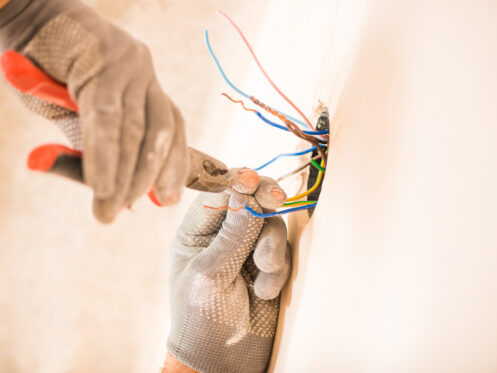In our country, there are many different types of appliances, electronics and power tools. These various devices come with different types of cords. The cord must match the type of electrical outlet it is plugged into for both safety and function. Most homes in the U.S. use a combination of different outlets to meet the homeowner’s various electrical needs. The most commonly used circuits are 15-amp, 20-amp and 120-volt. A 15-amp receptacle can be used in a 20-amp circuit, but a 20-amp receptacle cannot be used in a 15-amp circuit. Most homes have a mix of these. A 20-amp receptacle has an additional slot and is most often seen with appliances that require larger amounts of electricity, such as a microwave.
1. 15-Amp Duplex Receptacle
You are probably most familiar with a 15-amp duplex receptacle. This has two vertical slots and a U-shaped grounding hole. It is impossible to plug in a cord the wrong way with this type of outlet. You may have seen older outlets and plugs where the slots are the same size. Modern 15-amp outlets have different-sized slots so that the appliance is plugged in correctly at all times. This ensures it is properly grounded and prevents electrical shocks and fires.
2. Combination Outlets
These outlets provide two features in one device. The most commonly seen combination outlet is one that has the standard 15-amp circuit with additional USB outlets. A combination outlet can also be a plug-in and a switch combined in one outlet.
3. GFCI Outlet
GFCI stands for Ground Fault Circuit Interrupter. This outlet protects against electrical shocks, mostly when water is involved. It monitors the flow of electricity into and out of the outlet. When it senses a change, it will shut off the power to the outlet. Electrical code requires that these outlets are installed anywhere there is water being used, such as bathrooms, basements, certain areas of the kitchen and outdoors. If you’ve seen an outlet that has a small button on it that says ‘Reset’, it’s probably a GFCI outlet. After the power is shut off, you can press the button to restore it when the situation is safe again.
4. AFCI Outlets
AFCI stands for Arc Fault Circuit Interrupter. An arc fault is when an electrical current jumps between two wires. This jump can create a spark, which can lead to a fire. AFCI outlets protect against arc faults to prevent damage to your electrical cords. This can also prevent an electrical fire. The national code recommends but doesn’t require AFCI outlets to be in certain areas.
GFCI vs. AFCI
The difference between a GFCI and an AFCI is that the GFCI shuts off when it detects a problem with the ground, while the AFCI shuts off if it detects an arc fault. The outlets look very similar, so you may not know if your outlet is GFCI or AFCI. An electrician can check it out for you and tell you which one it is.
5. Tamper-Resistant Receptacle
Tamper-resistant receptacles are recommended in areas where there are children. This can include homes, schools or daycare centers. They are also known as child-proof or tamper-proof outlets. This outlet has built-in blocks that protect the outlet and prevent children from being able to insert things into the slots. Some parents have used plastic covers that are inserted into the prongs to protect their outlets and their children. However, these are removable. A tamper resistant receptacle is a permanent solution. They can be installed in place of either a 15-amp or 20-amp receptacle.
6. Weather-Resistant Receptacle
A weather-resistant receptacle protects the outlet from rain, ice and snow. They typically have a special cover that flips over the receptacle for protection. They are also made with UV-stabilized thermoplastic, which is resistant to corrosion. The electrical code dictates that weather-resistant receptacles are used in areas that are frequently wet or damp, such as pools, decks and patios. A weather-resistant receptacle can also be tamper resistant or GFCI.
7. Rotating Outlet
A rotating outlet has plugs that can rotate up to 360 degrees. These types of outlets are typically used in areas where there is a tight space. They can also be used if you wish to plug in more than one larger-sized plug. A rotating outlet can reduce the need for a power strip, as you can get more than one item plugged in in a smaller area.
8. Specialty Outlets
Some larger appliances, such as microwaves and dryers, require a specialty outlet. Your electrician will tell you if you need a specialty outlet. Sometimes the specialty outlets have additional features, such as a surge-suppression function right at the outlet. This will protect your appliance from power surges without the need for a separate power surge strip.
9. Split-Circuit Receptacles
A split-circuit receptacle has two outlets, each wired into a different circuit. This is a great option if you are looking to prevent overloading a single circuit. Another option with this type of receptacle is to have one outlet live and the other switched off until needed.
10. 30-amp or 50-amp 125V/250V Receptacle
These are specialty receptacles used for heavy-duty appliances, such as dryers, ovens and certain power tools. These provide as much as eight times the power compared to a normal receptacle. A 30-amp receptacle is able to handle 3,600 watts of electricity, and a 50-amp receptacle can handle up to 7,200 watts. These outlets have special configurations of prongs that are made for a specific type of cord.
11. Ungrounded and Unpolarized Outlets
If your home was built before the 1960s, chances are that you have several ungrounded and unpolarized outlets in your home. These are the outlets that have only two prongs. If you see these outlets in your home, they need to be upgraded. An ungrounded receptacle can cause electrical shock and fires. Call a licensed electrician to come take a look. They can advise you as to whether you should convert to GFCIs or if you need some rewiring done to ensure your safety.
12. USB Outlets
You can now get a regular 15-amp duplex receptacle that includes USB plug-ins. This can be a regular USB or USB-C. This is a great option when many of us have so many devices that use USB cords to charge. You don’t have to worry about having a charging box if you have a USB receptacle right on your normal outlet.
13. Smart Outlets
A smart outlet functions as a normal outlet. However, it can be controlled with your smartphone or other voice-assistant app. You can then remotely turn your lights on and off. You can also monitor your energy usage, which is a great feature. Then you can adjust accordingly to keep your energy bill under control.
There are so many different types of outlets available to choose from. But don’t worry about choosing the perfect one. If you are building a new home or rewiring your old one, a licensed electrician will be with you to help guide you in your decisions. Choosing an outlet depends on many factors, such as where the outlet will be located, what types of devices it is going to power and whether it needs to be child or weather-resistant.
3 Mountains Plumbing in Milwaukee has experienced licensed electricians who can help you understand and choose the correct outlet for your situation. Give us a call today!

